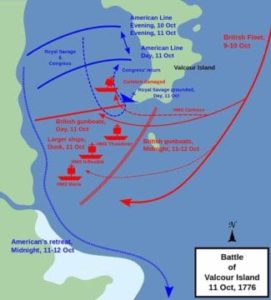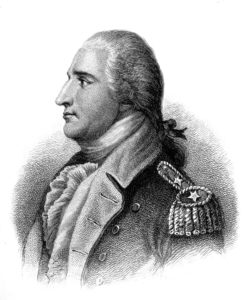
Valcour: The 1776 Campaign that Saved the Cause of Liberty
Jack Kelly’s latest history has done as much for Benedict Arnold’s reputation as Kenneth Robert’s Arundel. The difference being, Arundel was a historical novel and Valcour is a thorough treatment of the 1776 campaign to prevent the British from ascending1 lake Champlain to join Howe’s forces in New York. In many ways the books complement one another. The lake battle at Valcour island takes place on the heels of the ill-fated attack on Quebec which is covered in Robert’s novel. In both cases, one can not help but admire Arnold’s energy and determination.
Because the name Benedict Arnold has become synonymous with perfidy and treason, it is easy to forget the tremendous sacrifices he made on behalf of the fledgling United States during the first 4 years of American Revolution. The title of Kelly’s book indicates that Arnold’s role was critical. Valcour: The 1776 Campaign that Saved the Cause of Liberty. Kelly’s Arnold is a heroic figure with an outsized sense of self. Arnold struggled to balance self-awareness with the fact that life is not fair.
The Arnold that Kelly depicts has not yet succumbed to his resentment, and although it is presaged, at this point in his life Arnold could have taken another path. The Arnold in Kelly’s book was a brilliant leader and devoted patriot. In 1775, it was Benedict Arnold that proposed taking Fort Ticonderoga, and it was he and Ethan Allen that did so. It was cannons from the fort that enabled Washington to drive the British from Boston in March of 1775. Arnold demonstrated conspicuous bravery and leadership (with Daniel Morgan) in the subsequent Canadian campaign (the backdrop of Arunel), during which he was wounded in the leg. And it was Arnold who orchestrated and implemented the construction of a ragtag fleet on Lake Champlain the following year.
Arnold recognized the strategic significance of preventing the British forces in Canada from utilizing “the great warpath†(Lake Champlain) to join up with those of Howe in New York. Arnold played a game of intimidation and bluff, supported by his tactical leadership when push came to shove at Valcour island. First Arnold ramrodded the construction of a “fleet†consisting of a few schooners, gunboats and row galleys. He coordinated with Schulyer to obtain the necessary materiel and manpower, and boldly launched the fleet northward. Despite shortages in ammunition and powder, he exercised his ships’ cannon and took steps to ensure that the British were aware of his presence. This caused Carlton (leader of the Canadian forces) to hesitate and spend more time preparing so that they would be sure to overwhelm the Americans with disproportionate force.
Carlton didn’t count on Arnold’s perspicacity or his leadership abilities. Recognizing the importance of his mission – which was not to defeat the British, but to buy time – Arnold did his utmost to complete it, while at the same time convincing the British that the costs and risks of persisting in the campaign of 1776 were too high. To accomplish his mission would require more than a bluff. It had to be backed up with a credible demonstration of American resolve. Arnold was the right man at the right time.
 Knowing he would face a superior force composed of experienced mariners2, Arnold sought to even the odds by preparation and planning. He leveraged the work he had done exploring and surveying the lake in the months prior, and realized he could exploit the lake’s hydrographic features. Arnold concealed his forces in the strait between Valcour Island and the lake’s western banks, and caught the British off-guard. Carlton had assumed a quick and easy victory. His presence with the fleet undermined the authority of his naval commander, Thomas Pringle. Pringle was unfamiliar with Lake Champlain, unused to operating in such comparatively small confines, and failed to scout ahead. As on so many occasions during the war, weather conditions seemed to favor the Americans. But the Americans were also due an unpleasant realization. Benedict Arnold and his men were surprised by the number and power of the British gunboats. They had expected 7 or 8, and instead had to contend with 22! Some of these had larger cannon than any possessed by the Americans. After a bloody fight (during which a young Edward Pellew3 distinguishes himself), the British took out 11 of Arnold’s ships, killing or capturing 200 rebels.
Knowing he would face a superior force composed of experienced mariners2, Arnold sought to even the odds by preparation and planning. He leveraged the work he had done exploring and surveying the lake in the months prior, and realized he could exploit the lake’s hydrographic features. Arnold concealed his forces in the strait between Valcour Island and the lake’s western banks, and caught the British off-guard. Carlton had assumed a quick and easy victory. His presence with the fleet undermined the authority of his naval commander, Thomas Pringle. Pringle was unfamiliar with Lake Champlain, unused to operating in such comparatively small confines, and failed to scout ahead. As on so many occasions during the war, weather conditions seemed to favor the Americans. But the Americans were also due an unpleasant realization. Benedict Arnold and his men were surprised by the number and power of the British gunboats. They had expected 7 or 8, and instead had to contend with 22! Some of these had larger cannon than any possessed by the Americans. After a bloody fight (during which a young Edward Pellew3 distinguishes himself), the British took out 11 of Arnold’s ships, killing or capturing 200 rebels.
As night descended, it looked like the morning would bring about the total destruction of Arnold’s forces, now trapped. However, Arnold once again rallied his beleaguered men and managed to sneak through the British line of ships.
Arnold’s plan was as audacious as it was risky. Sailors on the American vessels would quietly raise their anchors and head south in the direction of the British fleet. They would escape not by retreating but by advancing.
…
To Benedict Arnold, the night following the battle was full of possibilities. To Carleton and Pringle, it held only certainty of their own fixed ideas. Just as they had been sure they would find the Americans waiting for them in Cumberland Bay that morning, they were convinced that the enemy would remain motionless in the channel opposite Valcour Island through the night.
When dawn broke, the British were astounded to find that the Americans had slipped past. Battling wind and tide, the remnants of the American fleet fled southward in advance of the powerful British ships, plying their oars with exhausted arms and backs.
Operating on limited sleep and under intense stress, on his galley Congress, BenedictArnold continued to invent new options for his fleet. Proceeding south toward Split Rock, the fight was starting all over again – and it went on for about 2 1/2 hours.
After an enormous expenditure of ammunition on October 11, after the extraordinary escape from British clutches, after a day and a half of flight down the lake, the Americans still had teeth.
All of this gave weight to the threat posed by the American and of their dogged determination. They had proven that they were not to be taken lightly, though the price was high.

By the time it was over, twenty-three of the seventy-three-man crew of the Congress had been killed, their adventure on behalf of the new nation ended. Now unless Arnold struck his colors, the seven British ships around him were preparing to move in and unleash a barrage that would destroy the American vessels and slaughter the crews. The men kept looking toward the general for a sign.
Finally Arnold gave the order — not to strike but once again to escape.
Once again, Arnold did the unexpected and took advantage of the fact that his gondolas could be maneuvered by oars. He reversed course causing the British ships to tack in order to follow. In the midst of this maneuver, Arnold reversed course again and headed for the mouth of Ferris Bay.
The cuplike opening was less than three hundred yards across. Arnold had made friends with Peter Ferris during his trips to and from Canada and his scouting expeditions on the lake. During the summer, he had dropped lines to sound the depths of the local waters. He knew the sheltered inlet was too shallow for larger ships to risk entering.
Rather than surrender his ships, Arnold left their flags flying as he burned them, a point of honor not missed by the British.
Pringle decided not to purse the remaining ships, providing yet another delay that would be used to good advantage by the Americans. Allowing themselves to be distracted by Arnold’s hi-jinx delayed their arrival at Crown Point and allowed the defenders time to prepare.
More importantly, Arnold’s actions had made an impression on the British general, his fanatical resolve had demonstrated the spirit of the men fighting for the cause. All of this factored in to Carlton’s decision that enough was enough and that, after all, winter was coming on. It was best to return to Canada.
Despite heavy losses, Arnold had achieved his true mission – buying time for the patriot cause and Washington’s troops in New York. By the final weeks of 1776, the American cause teetered on the brink of extinction. Arnold’s achievement prevented that. Some of the very men who fought at Valcour would go on to provide needed reinforcements for Washington’s attacks on Trenton and Princeton, victories that greatly improved the morale and unity of the colonial army and militias and ultimately turned the tide.
Knowing that Arnold would eventually trade his reputation for £20,000 and betray all he held dear, tinges the story with sadness. Arnold could have held a place of honor in the pantheon of American Heroes. He wasn’t unique in suffering political slights (both perceived and actual), he wasn’t the only officer with an ego that drove him to threaten resignation or mount political campaigns.
Assured of his own ability, Arnold’s egoism merged with his endurable belief in the republican principle of advancement by merit rather than by connections. He assumed that the representatives of the people would support him.
Reading about Arnold’s abilities and accomplishments can’t help but make one feel melancholic about what could have been.
1. Lake Champlain is only about 100’ above sea level and it flows north. “Because of the direction of flow, “up the lake†meant toward the south, a designation that ran counter to intuition and created confusion then as it does now.†Valcour, p11.
2. Though many of the men under his command were not experienced sailors, Arnold had extensive experience at sea, and was a ship-owner (3 merchantmen by the time he turned 26).
3. Some fans of C.S. Forester might recognize Pellew as Horatio Hornblower‘s mentor.
 The posts are coming!
The posts are coming!

0 comments
Kick things off by filling out the form below.
Leave a Comment